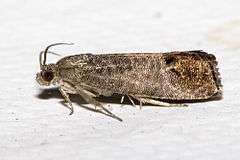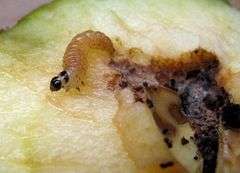Cydia (moth)
| Cydia | |
|---|---|
 | |
 | |
| Imago (above) and caterpillar (below) of the codling moth (C. pomonella) | |
| Scientific classification | |
| Kingdom: | Animalia |
| Phylum: | Arthropoda |
| Class: | Insecta |
| Order: | Lepidoptera |
| Division: | Ditrysia |
| Family: | Tortricidae |
| Subfamily: | Olethreutinae |
| Tribe: | Grapholitini |
| Genus: | Cydia Hübner, 1825 |
| Type species | |
| Phalaena (Tortrix) pomonella Linnaeus, 1758 | |
| Diversity | |
| About 215 species (but see text) | |
| Synonyms | |
|
Numerous, see text | |
Cydia is a large genus of tortrix moths, belonging to the tribe Grapholitini of subfamily Olethreutinae. Its distinctness from and delimitation versus the tribe's type genus Grapholita requires further study.[1][2][3][4]
Moths in this genus are generally small and dull brown; their caterpillars are yellow or white and wormlike. Cydia includes many species of economic importance due to the damage their caterpillars inflict as pests of agricultural crops, especially fruit and nut trees. On the other hand, some Cydia species have been used for biological control of invasive weeds, and many of these small moths and their caterpillars are an important food source for other animals. A few species from the Hawaiian Islands are suspected to be extinct due to disappearance of their food plants.
Another well-known species is the jumping bean moth (C. deshaisiana), whose caterpillars live in Sebastiania seeds, turning them into the famous "Mexican jumping beans".
Species
Roughly 215 species are currently recognized in Cydia, though as noted above, the list is provisional:[2]
- Cydia acerivora (Danilevsky in Danilevsky & Kuznetsov, 1968)
- Cydia adenocarpi (Ragonot, 1875)
- Cydia alabastrina Diakonoff, 1983
- Cydia alazon (Diakonoff, 1976)
- Cydia albimaculana (Fernald, 1879)
- Cydia albipicta (Sauter, 1968)
- Cydia alienana (Caradja, 1916)
- Cydia americana (Walsingham, 1879)
- Cydia amplana – rusty oak moth
- Cydia amurensis (Danilevsky in Danilevsky & Kuznetsov, 1968)
- Cydia anaranjada – slash pine seedworm moth
- Cydia aphrosema Diakonoff, 1987
- Cydia aphrospila (Meyrick, 1921)
- Cydia araucariae (Pastrana, 1951)
- Cydia archaeochrysa Diakonoff, 1986
- Cydia astragalana (Staudinger, 1871)
- Cydia atlantica Chambon & Frérot, 1985
- Cydia blackmoreana (Walsingham, 1903)
- Cydia bracteatana (Fernald in Comstock, 1881)
- Cydia brownorum Rose & Pooni, 2003
- Cydia callizona (Meyrick, 1911)
- Cydia canariensis (Kuznetzov, 1972)
- Cydia candana (Forbes, 1923)
- Cydia caradjana (Rebel, 1910)
- Cydia caryana – hickory shuckworm moth
- Cydia celiae (Clarke, 1976)
- Cydia charops (Diakonoff, 1971)
- Cydia chelias (Meyrick, 1907)
- Cydia chlorostola (possibly extinct)
- Cydia cognatana (Barrett, 1874)
- Cydia colorana Kearfott, 1907
- Cydia commensalana (Danilevsky, 1963)
- Cydia confusana (McDunnough, 1935)
- Cydia conicolana (Heylaerts, 1874)
- Cydia coniferana (Saxesen in Ratzeburg, 1840)
- Cydia conoterma (Meyrick, 1922)
- Cydia conspicua
- Cydia cornucopiae (Tengstrom, 1869)
- Cydia corollana (Hübner, [1823])
- Cydia cosmophorana
- Cydia costastrigulana (McDunnough, 1935)
- Cydia crassicornis (possibly extinct)
- Cydia cryptomeriae (Issiki in Issiki & Mutuura, 1961)
- Cydia cupressana Kearfott, 1907
- Cydia curiosa Razowski, 2009
- Cydia curitibana Schönherr, 1987
- Cydia curvivalva Liu & Yan, 1998
- Cydia cytisanthana Burmann & Pröse, 1988
- Cydia dadionopa (Diakonoff, 1976)
- Cydia daedalota (Meyrick, 1916)
- Cydia dalbergiacola Liu, 1992
- Cydia damascana (Razowski, 1966)
- Cydia danilevskyi (Kuznetzov, 1973)
- Cydia defensa (Meyrick, 1922)
- Cydia derrai Pröse, 1988
- Cydia deshaisiana – jumping bean moth
- Cydia deyana (Chrétien, 1915)
- Cydia dissulta Diakonoff, 1983
- Cydia dochmasima Diakonoff, 1987
- Cydia doria (Clarke, 1976)
- Cydia duplicana
- Cydia elpore (Diakonoff, 1976)
- Cydia ergoda Razowski, 2013
- Cydia ermolenkoi (Danilevsky in Danilevsky & Kuznetsov, 1968)
- Cydia erotella (Heinrich, 1923)
- Cydia ethelinda (Meyrick, 1934)
- Cydia eucyanea Walsingham, 1914
- Cydia eudesma Walsingham, 1914
- Cydia exquisitana (Rebel, 1889)
- Cydia fabivora (Meyrick, 1928)
- Cydia fagiglandana – beech moth
- Cydia fahlbergiana (Thunberg, 1797)
- Cydia falsifalcellum
- Cydia farsica (Kuznetzov in Danilevsky & Kuznetsov, 1968)
|
|
Former species
- Cydia euryteles (Meyrick, 1936)
Synonyms
Obsolete scientific names (junior synonyms and others) of Cydia are:[1][4]
|
|
In addition to the uncertain relationship of Cydia and Grapholita already mentioned above, the synonymy of the present genus has been subject to some confusion with its close relative Pammene: Eucelis, Trycheris and Orchemia are sometimes[3] listed as junior synonyms of Cydia, but the type species of the former two is Tortrix mediana (a junior synonym of P. aurana), and that of the third is Orchemia gallicana (a junior synonym of P. gallicana).[5]
References
- 1 2 Baixeras, J.; Brown, J.W. & Gilligan, T.M. (2009a): Online World Catalogue of the Tortricidae – Cydia genus account. Version 1.3.1. Retrieved 2009-Jan-20.
- 1 2 Baixeras, J.; Brown, J.W. & Gilligan, T.M. (2009b): Online World Catalogue of the Tortricidae – Cydia species list. Version 1.3.1. Retrieved 2009-Jan-20.
- 1 2 Savela, Markku (2005a): Markku Savela's Lepidoptera and some other life forms – Cydia. Version of 2005-Sep-13. Retrieved 2010-Apr-19.
- 1 2 Savela, Markku (2005b): Markku Savela's Lepidoptera and some other life forms – Grapholita. Version of 2005-Sep-13. Retrieved 2010-Apr-19.
- ↑ Baixeras, J.; Brown, J.W. & Gilligan, T.M. (2009c): Online World Catalogue of the Tortricidae – Pammene genus account. Version 1.3.1. Retrieved 2009-Apr-19.
| Wikimedia Commons has media related to Cydia. |